Menus
- Sports tourers in the comparison test
- Sonor shoots it out of the chrome-plated exhaust
- BMW and gearbox
- Skepticism as if wiped away
- The cost price is almost 14,000 euros
- And the Kawasaki Z 1000 SX?
- Tough competitor for the BMW R 1200 RS
- Four cylinders versus two
- The Z 1000 SX could do a lot more
- SX chassis knows how to please
- BMW defends its title
- MOTORCYCLE test result
- Price comparison for used BMW R 1200 RS and Kawasaki Z 1000 SX

r-photography.info
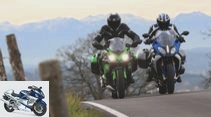
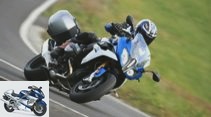
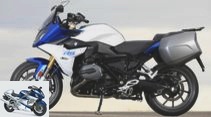
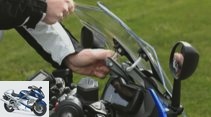
18th photos
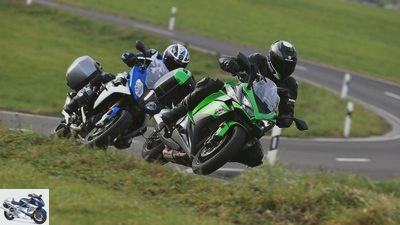
r-photography.info
1/18
BMW R 1200 RS and Kawasaki Z 1000 SX.
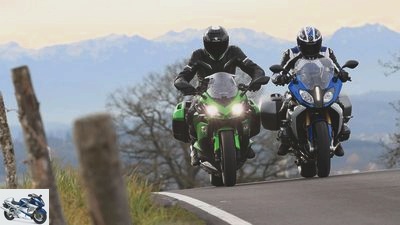
r-photography.info
2/18
BMW R 1200 RS and Kawasaki Z 1000 SX.
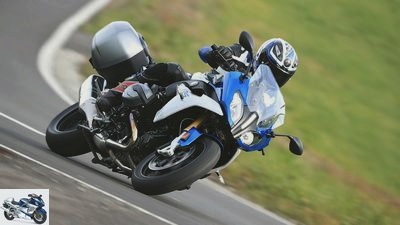
r-photography.info
3/18
BMW R 1200 RS.
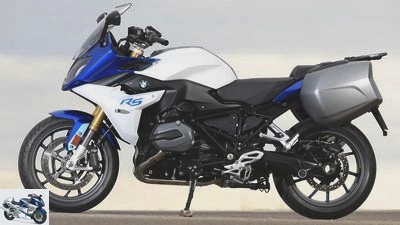
r-photography.info
4/18
BMW R 1200 RS.

r-photography.info
5/18
The window on the BMW can be raised or lowered manually.
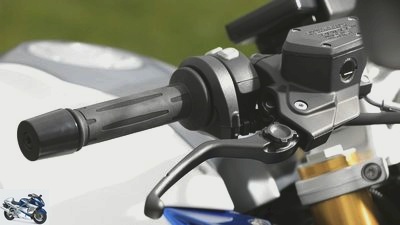
r-photography.info
6/18
The brake lever can also be adjusted; the free travel is irritating when pressed.
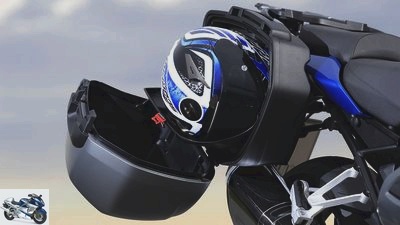
r-photography.info
7/18
The suitcases fold open wide, take hold of a full-face helmet without inside pockets.
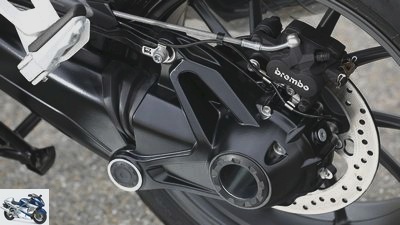
r-photography.info
8/18
The cardan of the single swing arm does not require extensive maintenance and transfers the power of the boxer to the rear wheel.
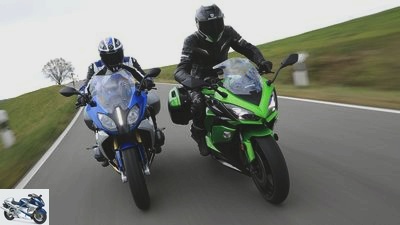
r-photography.info
9/18
BMW R 1200 RS and Kawasaki Z 1000 SX.
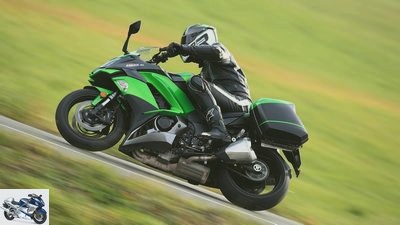
r-photography.info
10/18
Kawasaki Z 1000 SX.
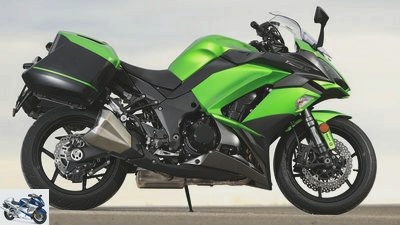
r-photography.info
11/18
Kawasaki Z 1000 SX.
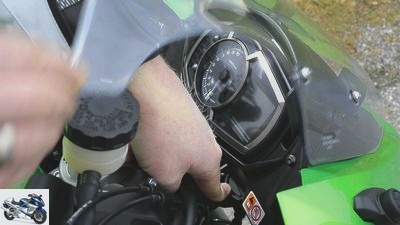
r-photography.info
12/18
One pressure and the disc is steeper.
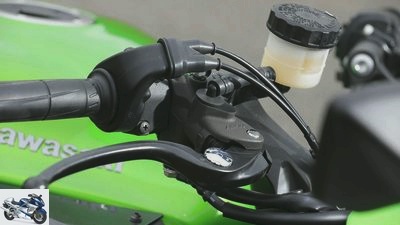
r-photography.info
13/18
The radial hand brake pump impresses with its fine controllability.
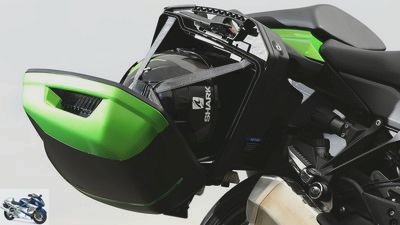
r-photography.info
14/18
They put away something: even the Kawa suitcase swallow a full-face helmet.
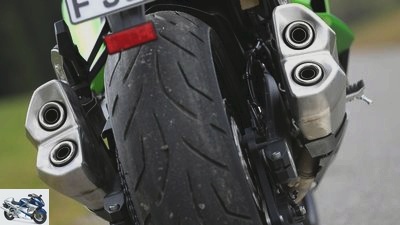
r-photography.info
15/18
Two double flutes, two-sided swing arm and chain: the rear view of the Z 1000 SX.
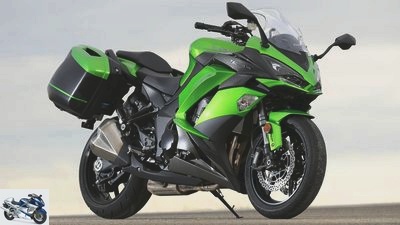
r-photography.info
16/18
Best Z 1000 SX ever! Lots of points, less money and a winner in terms of value for money.
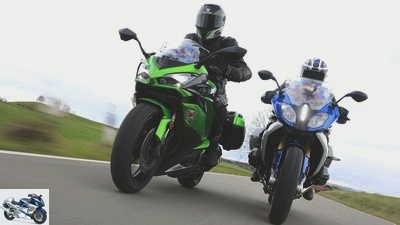
r-photography.info
17/18
In the overall standings, however, the BMW is ahead. There is really nothing to complain about with the test vehicle, which is equipped with many equipment options.
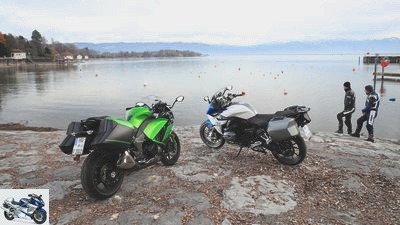
r-photography.info
18/18
Photo gallery: Comparison test sports tourer BMW R 1200 RS and Kawasaki Z 1000 SX.
BMW R 1200 RS and Kawasaki Z 1000 SX
Sports tourers in the comparison test
The BMW R 1200 RS is the sport touring leader. Therefore, in the course of the Euro 4 update, there were only detailed improvements. It looks different with the Kawasaki Z 1000 SX. It has been thoroughly revised. Is that enough to saw the throne of the Bavarian sports tourer king?
BMW has been counting since 2015 R. 1200 RS back to the BMW range. The big boxer is based on the naked R 1200 R, fairing and windshield make it a sports tourer. In the test version, it gathers everything that the Munich-based company offers in terms of special equipment. In addition to the Comfort package, there are the Touring and Dynamic packages as well as a few other extras such as Shift Assistant Pro or keyless operation. At first glance, a fine thing. But one thing remains: the basic price of 13,700 euros becomes a test vehicle price of 16,840 euros. And this only includes the features that are essential for the assessment. Accessories such as cases are left out. That’s a lot. And at the same time arouses high demands. What is so expensive has to work really well.
Buy complete article
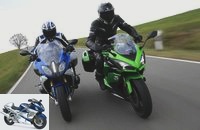
BMW R 1200 RS and Kawasaki Z 1000 SX
Sports tourers in the comparison test
Data is just theory
When browsing through the technical data, there are slight doubts. At 1,530 millimeters, the wheelbase of the BMW R 1200 RS is very long. A 62.3 degree steering head angle and a caster of 115 millimeters: That doesn’t sound like a handling miracle. And when the weight of a full 246 kilograms comes into play, everything that looks like cornering fun seems to be over for good. But the data is only theory. As in football, what counts is what happens on the pitch – in this case the street. So now approach the matter with an open mind.
Sonor shoots it out of the chrome-plated exhaust
When you sit up, you immediately notice the extremely generous amount of space in the BMW R 1200 RS. Long and wide, the seat cushion covers the very best at a seat height of 820 millimeters. This would also be possible in 790 or 840 millimeters at no extra charge. The tank rises large in front of the stomach, the arms stretch a little towards the handlebars in stubby optics. One press of the starter and the 1,170 cm³ flat twin comes to life. Sonor thunders it from the chrome exhaust. The engine with a compression ratio of 12.5: 1 sends an unexpectedly large amount of sound towards the outlet – despite the Euro 4 standard.
BMW and gearbox
The clutch of the BMW R 1200 RS requires little manual force; first gear engages hard. BMW and transmission – in this life this will probably no longer be a really harmonious relationship. The next gear changes can be made slightly rough using the automatic gearshift, or using the blipper again down to gear stage one. At low engine speeds, the gearshifts in the first three stages work more smoothly with the clutch than with the automatic gearshift. At changing speeds or above 3,500 rpm, however, it works smoothly, almost better with the gearshift support. As part of the Euro 4 update, BMW has given the R 1200 RS the same jerk damper on the transmission output shaft known from the 2017 GS (MOTORRAD 23/2016), and has also revised the shift drum actuation. The “clunk” when engaging first gear mitigates that, but it would be really good again.
Skepticism as if wiped away
No matter, because the sports tourer can now do meters. According to the display, the temperatures are just above freezing point, which suggests a careful driving style. Nevertheless, the barely readable tachometer shows ever higher values. The BMW R 1200 RS simply inspires confidence, takes you by the hand. The Metzeler Z8 with special codes M (front) and C (rear) also contributes to this. The sports tourer turns the corner with ease, and a view towards the exit of the curve is almost enough. The initial skepticism regarding driving behavior has been wiped away. The boxer emphatically develops his performance when swinging from curve to curve, runs really smoothly right at the bottom and pushes man and machine forward quickly from 4,000 tours. The chassis is in no way inferior to this performance. Thanks to the semi-active damping, valves operate in the fork and shock absorber that constantly adjust the rebound and compression levels. How does that feel? When accelerating, for example, the valve in the shock absorber tightens the compression stage. The rear does not sag, remains stable, the R 1200 RS hits exactly the intended line. A similar game when braking. The fork’s pressure damping closes automatically. The front compresses it less than normal forks, despite the slow deceleration in the ABS control range. That also keeps the rear securely on the ground. Brutal anchoring as easy as pie.
The cost price is almost 14,000 euros
Even if a passenger lounges behind the driver in the comfortable seat in the second row, the BMW R 1200 RS lies as if the brakes have to perform at their best. That impresses. And because the wind protection on the Boxer is passable and its consumption of 4.7 liters is sufficient for 383 kilometers at a time, points of criticism are difficult to identify. Applying the brake would be such a thing. The conventional brake lever has too much free travel and has to be pulled quite a bit until the pressure point is applied. The adjustment option does not change anything. The effect is right, but there is a bit of a problem with the dosage. A radial hand pump would be one solution. That is missing. With a cost price of almost 14,000 euros for a motorcycle, this is not one hundred percent understandable, because otherwise, from an objective point of view, the BMW is an almost perfect model student in the sports tourer universe. Even people without a propeller tattoo on their upper arm have to admit this without envy.
And the Kawasaki Z 1000 SX?
Of course, they would rather go for the Kawasaki Z 1000 SX. For 2017, the third generation will be launched. The update according to the Euro 4 standard was also the top priority for the new season for the sports tourer from Akashi. Kawasaki did not leave it at that, but went straight to the limit. The look now borrows from the super sports car ZX-10R, the front points aggressively forward. In addition, the three-way adjustable disc grew by 15 millimeters in height, the chassis was further trimmed in the direction of comfort with different shim packages and modified deflection on the shock absorber. Also new are the wide driver’s seat and the Japanese sports tourer’s electronics package, which has been expanded to include an IMU (Inertial Measurement Unit).
Tough competitor for the BMW R 1200 RS
The BMW R 1200 RS trembles slightly on the main stand with this upgrade. Does the Teutonic RS boxer run the risk of losing his place on the sports tourer’s sundeck? The Kawasaki Z 1000 SX definitely has good systems for this. With a wheelbase of 1440 millimeters, a steering head angle of 65.5 degrees and 102 millimeters of caster, the data for the chassis promise a good combination of handiness and stability of the 236 kilogram heavy Kawa. It is now time to test it. The seating arrangement on the SX is significantly more compact than on the BMW. The knee angle forces the upper and lower legs more together, the driver’s seat, which is now wider and padded, offers less space to slide back and forth. A disadvantage? Objectively yes, subjectively not necessarily. Top tester Georg Jelicic, who is just over 170 centimeters tall, gets along better with the expansive BMW boxer, while the two-meter tall author likes the more restricted space on the Z 1000 SX. It just feels sportier, more direct, crisper. But feelings have nothing to do with points, so now again to relevant standards.
Four cylinders versus two
With them, the engine comes to the fore. Four cylinders versus two in the BMW R 1200 RS, smaller individual and lower overall displacement, but much more revving power: these ingredients are good for driving performance values on the level of the R 1200 RS or just above. In addition, there is the relatively short translation of the Kawasaki Z 1000 SX. You only want that a little longer for the speed bolt on the autobahn in order to lower the speed. It is ideal on the country road. The clutch disengages with ease, and the gears engage securely, but hard and gnarled. The four-cylinder measuring 1,043 cm³ hangs neatly on the gas. The poor response behavior of the double throttle valves, which was often mentioned before, cannot be felt. Even though: The BMW can do it a little finer.
The Z 1000 SX could do a lot more
Almost as light as a feather, the Kawasaki Z 1000 SX whizzes through all kinds of curves, emphasizing the sport theme with a brisk swing. But only as long as the tires, Bridgestones S 20 in special specification N, are allowed to shine when new. Once warmed up, they grip like the devil, even at the low test temperatures they bite firmly on the asphalt. But with every kilometer they lose a bit of their famous demeanor, they need more emphasis on the steering impulse and require constant slight corrections while cornering. This is a shame, because the Z 1000 SX could actually do a lot more, but it degrades more and more during the 500 kilometers of test operation in terms of handiness, stability and steering behavior.
SX chassis knows how to please
This does not apply to the new electronics. IMU data-fed, traction and wheelie control as well as ABS get to work. The traction control, which can be set and switched off, finely regulates the propulsion if required, and the ABS also impresses with its sensitive control behavior. The fact that the Kawasaki Z 1000 SX does not anchor as stably as the BMW R 1200 RS in spite of the better metered stoppers is primarily due to the newly tuned chassis. When fully loaded, the fork compresses a lot when decelerating and can move the rear wheel. The previous model with a harder chassis setup, but poorer ABS control behavior, was even more critical. So internally at Kawasaki this is progress. But the BMW does it even better. You have to hold onto that too. Otherwise, the chassis of the SX knows how to please. Kommod irons unevenness out of the way, thanks to many adjustment options there is enough scope for individual setups.
BMW defends its title
The LED light illuminates the roadway really well. The low beam and high beam are present in both headlights, which together now cast a large-format light cone into the darkness of the night. That leaves the consumption: The four-cylinder gets by with 5.2 liters per 100 kilometers, which gives a range of 365 kilometers. Here, too, the BMW is slightly ahead. In terms of costs, that doesn’t really matter, because the Kawasaki is now pulling its ace out of its sleeve and playing its most important trump card: the price. It is available from dealers for 12,995 euros. Points-relevant extras are not added. The bottom line is that it is not the better sports tourer, but the much cheaper one. And thus the best Kawasaki Z 1000 SX that has ever existed. Only the throne of the BMW R 1200 RS has not yet been shaken, the white-blue still reigns supreme in its segment.
MOTORCYCLE test result
BMW R 1200 RS: The BMW follows the dictates of perfection. There is really nothing to complain about with the test vehicle, which is equipped with many equipment options. This ensures a filled points, but also an empty bank account. Kawasaki Z 1000 SX: The SX approaches the topic of sports touring from the sporty side. Thanks to the current update, it has gotten better in many details. It’s not enough to win, but you can get over that with the price difference to the BMW
The technical data, 1000-point evaluation and the measured values determined by us, including all consumption, pull-through and acceleration values, are available as PDF for download or in the booklet.
Price comparison for used BMW R 1200 RS and Kawasaki Z 1000 SX
1000PS marketplace app
Strong sports tourers beckon for a tour for two.
Powerful sports tourers such as the R 1200 RS or Z 1000 SX are particularly suitable for traveling as a couple, which is why they are very popular on the used market. The selection of used sports tourers is large and many of them are already equipped with top cases or side cases. Here is a current overview of the used market: used BMW R1200RS and Kawasaki Z1000SX in Germany.
Related articles
-
Comparison test Honda VFR 800 F, Kawasaki Z 1000 SX and BMW R 1200 RS
fact 32 pictures fact 1/32 The Honda VFR 800 F looks small and compact, but carries a lot of weight with it: 245 kg with a full tank. fact 2/32 The …
-
Kawasaki Z 1000 SX 2017 in the test
13 pictures 1/13 Kawasaki Z 1000 SX model year 2016 and 2017 in comparison. 2/13 …
-
Comparison test Suzuki SV 650, Honda CB 650 F, Kawasaki ER-6n, Yamaha MT-07
www.bilski-fotografie.de 34 pictures www.bilski-fotografie.de 1/34 They are the hottest candidates among the middle class naked bikes ….
-
Comparison test Kawasaki GTR 1000, Triumph Trophy 1200, Yamaha FJR 1300
fact comparison test Kawasaki GTR 1000, Triumph Trophy 1200, Yamaha FJR 1300 As time goes by In honor grayed out ?? and still to have: two veteran …
-
Kawasaki Z 800, Yamaha MT-09 and BMW F 800 R in a comparison test
35 pictures 1/35 The center is no longer where it used to be. Because bikes with displacements around 800 cm³ count …
-
factstudio.de 29 photos fact 1/29 One against all. Ducati SuperSport S in comparison test with Suzuki GSX-S 1000 F, Kawasaki Z 1000 SX, Honda VFR 800 F…
-
Gargolov Top test Kawasaki ZZ-R 1200 Heavy hum A sports tourer, mighty, strong, carved from the solid: the Kawasaki ZZ-R 1200. By no means perfect, but…
-
Comparison test between Kawasaki GPX 600 R and Suzuki GSX 600 F
Comparison test between the Kawasaki GPX 600 R and the Suzuki GSX 600 F Signs of aging What they are missing in terms of youthful elasticity after more than ten years of service …
-
Sports tourer BMW K 1300 S, Honda VFR 1200 F and Suzuki GSX-S 1000 F in the test
fact 30th photos fact / Joachim Schahl 1/30 Sports Tourer? Do they still exist? But of course! It may be that Multistrada, Adventure and Co. have badly…
-
Kawasaki Z 300 and KTM 390 Duke in comparison
Bilski 25 pictures Bilski 1/25 Around 5000 euros are due for the Kawasaki Z 300 and KTM 390 Duke. Bilski 2/25 While the number on the right …